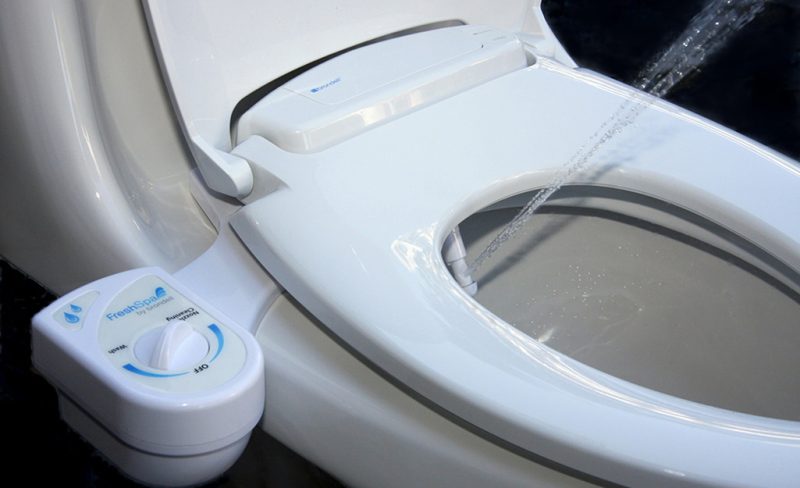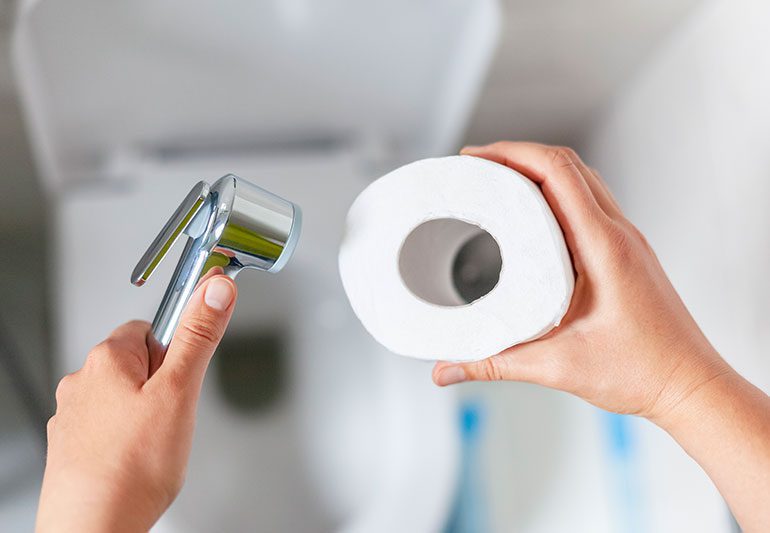Although different types of bidets are flooding the market, many don’t know how to use them. Understanding the procedure of using a bidet will help in enjoying the toilet process and likewise maintain your bidet from damage in the long run.
A bidet is a bathroom accessory widely used worldwide, especially in Europe and Asia. After using the restroom, you can use a bidet to clean the genital and anal areas with water, offering a more comprehensive cleansing than using toilet paper alone.
When using a bidet for the first time, it may be complex and confusing, but with this thorough help guide, you’ll be an expert in no time.
In this guide, we’ll cover the following topics: understanding the different types of bidets, how to use a bidet (step-by-step guide for every type of bidet), additional tips for using a bidet, and how to clean and maintain your bidet.
Without further ado, let’s dive into the world of bidets.
Understanding the Different Types of Bidets
Bidets come in a variety of designs and models, including:
Standalone bidet
These bidets are mainly seen in old homes in European or Asian countries. They are a distinctive fixture from your toilet. That is, they are different from your toilet but look like a small, low sink next to them. Since standalone bidets look similar to toilets, people sometimes mistake them.
Bidet seat
A toilet seat with built-in bidet functions is known as a bidet seat. It is a gadget you can attach to your current toilet and takes the place of the typical toilet seat. A bidet seat typically features a nozzle that can be adjusted to spray water for cleaning the user’s genital and anal area after using the toilet.
Moreover, certain bidet seats can have features like heated seats, warm water, air dryers, and programmable water pressure and temperature. In many countries, bidet seats are preferred over toilet paper since they are more hygienic and environmentally friendly.
Bidet attachment
A bidet attachment is a device that can be added to an existing toilet to provide bidet functions. Unlike a bidet seat which replaces the entire toilet seat, a bidet attachment is mainly attached to a bidet seat. It often has a nozzle that sprays water to clean the user’s genitals and anal area after using the toilet. It also has options for a feminine wash, adjustable water pressure, and temperature.
Handheld bidet
A handheld bidet is a hose or sprayer installed near your toilet. Several world regions, including Southeast Asia, the Middle East, and South America, regularly utilize handheld bidets.
As more individuals become aware of the advantages of using a bidet for personal hygiene, this type of bidet becomes more common in other parts of the world. Roughly speaking, handheld bidets are affordable and straightforward to install. They are also incredibly adaptable and may be used for various tasks, including bathing dogs, watering plants, and cleaning the toilet bowl.
Portable bidet
A portable bidet is a compact, hand-held toilet that you may carry around with you, unlike traditional bidets that are installed in bathrooms. It is often used to clean your private parts while you’re on the go and is loaded with water.
Toilet bidet combo
A toilet and a bidet are combined into one bathroom fixture, known as a bidet combination. These combination units are made to combine the functions of a toilet and a bidet into one compact unit. This type of bidet is the most expensive type of all bidets and the most sophisticated one.

How to Use a Bidet: Step-By-Step Guide for Every Type of Bidet
Having explained the types of bidets, this guide will go into deep detail describing how to use each bidet mentioned above.
How to Use a Standalone Bidet
Use the toilet first
To use a standalone bidet, you must first use the toilet as you usually would and wipe yourself with toilet paper to remove any solid waste. Then move to a standalone bidet next to the toilet.
Adjust the water temperature
Some standalone bidets come with hot and cold water temperatures. Therefore, turn the hot and cold water knobs to adjust the water temperature to your liking.
Position yourself
Unlike other bidets, you straddle a standalone bidet, facing the water faucet.
Turn on the water
Standalone bidets usually come with knobs. After positioning yourself, turn on the water using the knobs, and allow the water to flow for a few seconds to ensure it is at the right temperature.
Adjust the water pressure
Use the knob to adjust the water pressure to a preferred level.
Clean yourself
While the water from the bidet nozzle is pouring into your private area, use your hand to assist in the washing process. Start from the front and move towards the back. You can also use soap or a liquid wash if desired.
Dry off
Use a towel or toilet paper to dry yourself off after cleaning.
Turn off the water
Ensure you turn off the water knobs when you’re done cleaning.
Clean the bidet
Once you’re done, clean and rinse the bidet with a mild soap or cleaning solution and water, and wipe it down with a towel or cloth to maintain its hygiene.
How to Use a Bidet Seat, Bidet Attachment or Bidet Combo
The process of using a bidet seat, bidet attachment, and bidet combo is the same. Thus, to not prolong this guide, we’ll be combining these three bidet types. Here are some general guidelines on how to use these bidets:
Using the toilet
Start using your toilet as usual — no need to flush the toilet after you’re done. Don’t worry the feces water won’t splash on your private area.
Use the controls
While still sitting, use the control panel or the remote control to activate the bidet. A side panel controls some bidet seats and all bidet attachments. In contrast, all bidet combos and some bidet seats are controlled with an external remote control. Turn the water on through the remote control, and the water will start flowing from the nozzle beneath you.
Adjustment
Test and adjust the water pressure and temperature to suit your desire. To ensure you are thoroughly cleansed, you can adjust the nozzle position to target your private regions by shifting or positioning yourself. However, some nozzles can automatically adjust themselves.
Washing process
While the nozzle sprays out water, it’s washing you simultaneously. Unlike the standalone bidet, there’s no need to use your hand to wash down there, although some people prefer to do this. You can also use soap for additional cleanness.
Drying
When you’re finished, pat yourself dry with some toilet paper or a towel. For some bidet seats and bidet combo, the air dryer can dry you out, but you will need a bidet towel for bidet attachments.
Finishing
Turn off the bidet seat, flush the toilet, and wash your hands thoroughly with soap and water.
How to Use a Handheld Bidet or Bidet Sprayer
Using the toilet
Use the toilet as you would. Once you’re done, use toilet paper to remove most of the waste before getting ready to use the handheld bidet.
Turn on the T-valve
Turn on the T-valve under the toilet tank to allow water to flow into the bidet.
Locate the handheld bidet
Handheld bidets are usually easy to locate on a hook or holder next to the toilet that is fixed on the wall so you can hang them.
Test the water pressure
Before using the handheld bidet, check the water pressure to make sure it is not too high. Gradually turn the faucet on with low pressure to prevent any potential irritation.
Change the water temperature
Depending on your handheld bidet model, you may be able to change the water temperature. To make sure it’s comfy, test the temperature with your hand. If your handheld bidet doesn’t provide warm water, skip this step.
Aim and spray
Hold the handheld sprayer or bidet and point it in the direction of the area you want to clean. Start with a light trickle of water and increase pressure as necessary. To prevent the spread of bacteria, direct the stream from front to back for women.
Drying
Handheld bidets don’t come with an air dryer. Thus, dry up with some toilet paper or a bidet towel after using the handheld bidet.
Nozzle and bidet maintenance
The nozzle of the bidet sprayer should be cleaned with soap and water after each use and dried before the bidet is used again. However, this is not compulsory but necessary. Additionally, it would be best to hang your bidet on the hook beside the toilet. This prevents keeping it on the floor and spraying germs.
Turn off the T-valve
Before leaving the bathroom, turn off the T-valve to prevent water from splashing everywhere or leaking.
How to Use a Bidet Bottle or Portable Bidet
Here are the steps for using a bidet bottle:
- The bottle can be refilled from a basin or a tap with warm or cold water.
- Use toilet paper to wipe yourself down first after using the restroom to remove any solid waste.
- With your dominant hand, take the bidet bottle. Ensure that the bottle’s tip is aimed at your private area.
- Squeeze the bottle gently to allow the water to trickle over your genitalia. You can modify the water flow by adjusting the pressure on the bottle.
- If necessary, clean yourself with your fingers using the other hand.
- Use toilet paper or a bidet towel to dry yourself once you feel clean.
- For subsequent usage, rinse the bidet bottle and refill it with water.

Additional Tips for Using a Bidet
- It’s best to start with lower water pressure and temperature settings if you’ve never used a bidet before until you’re comfortable with the water’s sensation.
- The bidet should always be cleaned after each use to avoid the growth of bacteria and other germs.
- After using any bidet, be sure to always dry off with a different towel after washing. It’s also beneficial for your private area. Use a separate towel to dry your hands; do not use the same one.
- If you use a bidet seat, be sure to routinely clean the bidet to avoid the growth of bacteria.
- If you are visiting a place where bidets are widely used, be sure to educate yourself on the appropriate usage habits.
How to Clean and Maintain Your Bidet
Your bidet must be cleaned and maintained regularly in order to perform correctly and stay hygienic. These are some actions to take:
Regularly clean the nozzle
If your bidet has a nozzle, you must clean it regularly in order to stop the growth of bacteria. Clean the nozzle gently with a gentle brush and warm, soapy water, then completely rinse it.
Clean the exterior
To clean the exterior of your bidet, including the seat and lid, use a soft cloth and mild soap. Use water to rinse; then pat dry with a towel.
Deep-clean the bowl
If your bidet has a bowl, clean it on a regular basis using a mild cleanser.
Inspect for leaks
Regularly inspect the water supply and drain pipes for leaks. To avoid water damage, fix any leaks immediately if you find them.
Use the right cleanser
It’s best to utilize only the manufacturer’s approved cleaning supplies to prevent your bidet from being harmed. Do not use acidic or abrasive cleaners.
Properly store the bidet
To avoid mold growth when storing your bidet for an extended length of time, be sure to drain all water from the hoses and nozzle. This is more concerning if you’re using a handheld. You should keep them in a cold, dry environment.
Conclusion
Having learned how to use a bidet, we understand that it may initially appear confusing. However, it’s pretty simple if you get the hang of it. The fundamental procedures are almost the same whether you select a standalone or bidet seat. Periodical usage can help you become an expert soon.
